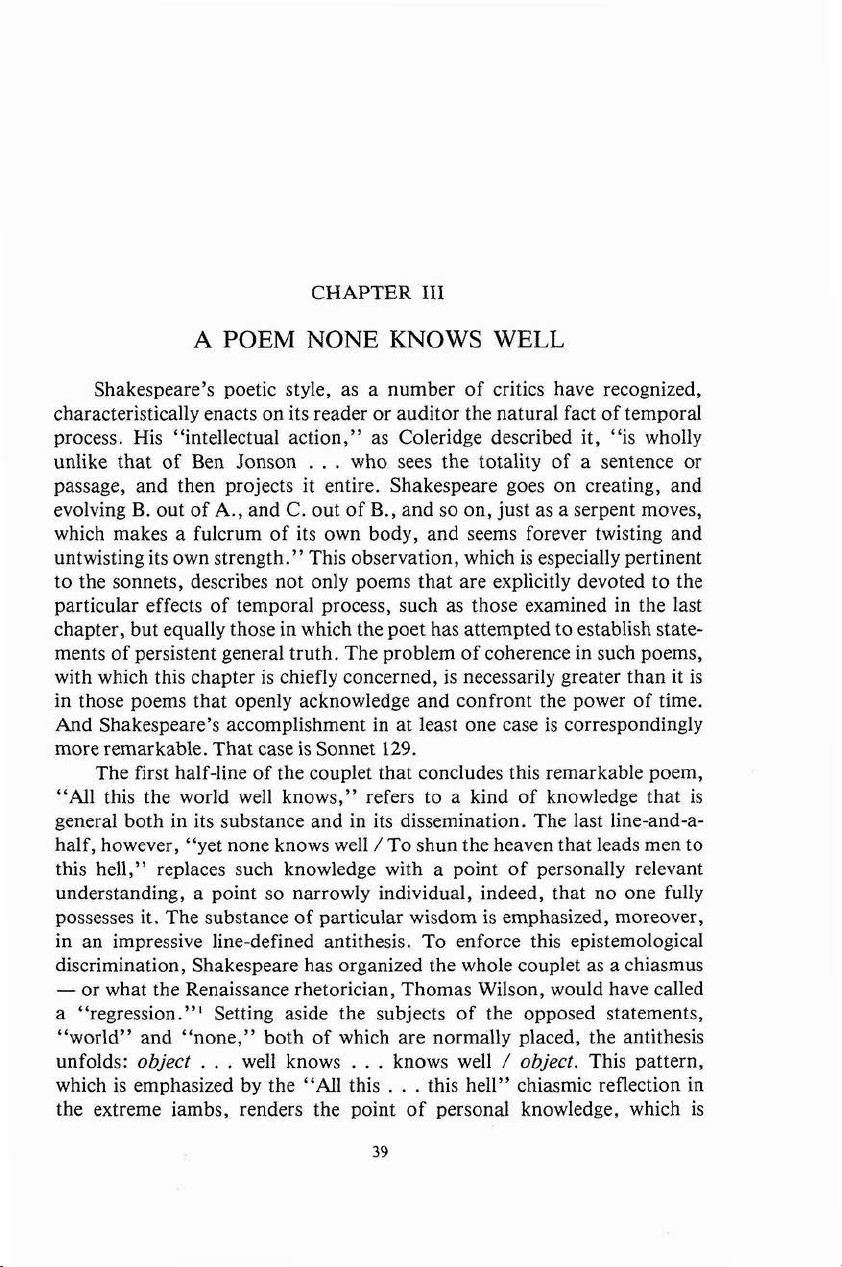











Study with the several resources on Docsity

Earn points by helping other students or get them with a premium plan


Prepare for your exams
Study with the several resources on Docsity

Earn points to download
Earn points by helping other students or get them with a premium plan
Community
Ask the community for help and clear up your study doubts
Discover the best universities in your country according to Docsity users
Free resources
Download our free guides on studying techniques, anxiety management strategies, and thesis advice from Docsity tutors
An in-depth analysis of Shakespeare's poem, focusing on the abstract nature of lust and the poet's use of rhetoric and meter to challenge the reader's understanding. the interlocking phases of lust and the poet's manipulation of language to prompt personal applications and reassessments.
Typology: Exercises
1 / 16

This page cannot be seen from the preview
Don't miss anything!










Shakespeare's poetic style, as a number of critics have recognized, characteristically enacts on its reader or auditor the natural fact of temporaI process. His "intellectual action," as Coleridge described it, "is wholly
passage, and then projects it entire. Shakespeare goes on creating, and evolving B. out of A., and C. out of B., and so on, just as a serpent moves, which makes a fulcrum of its own body, and seems forever twisting and untwisting its own strength." This observation, which is especially pertinent to the sonnets, describes not only poems that are explicitly devoted to the particular effects of temporal process, such as those examined in the last chapter, but equally those in which the poet has attempted to establish state- ments of persistent general truth. The problem of coherence in such poems, with which this chapter is chiefly concerned, is necessarily greater than it is in those poems that openly acknowledge and confront the power of time. And Shakespeare's accomplishment in at least one case is correspondingly
The first half-line of the couplet that concludes this remarkable poem, "All this the world well knows," refers to a kind of knowledge that is general both in its substance and in its dissemination. The last line-and-a- half, however, "yet none knows well / To shun the heaven that leads men to this hell," replaces such knowledge with a point of personally relevant understanding, a point so narrowly individual, indeed, that no one fully possesses it. The substance of particular wisdom is emphasized, moreover, in an impressive line-defined antithesis. To enforce this epistemological discrimination, Shakespeare has organized the whole couplet as a chiasmus
a "regression."' Setting aside the subjects of the opposed statements, "world" and "none," both of which are normally placed, the antithesis
the extreme iambs, renders the point of personal knowledge, which is
40 RICE UNIVERSITY STUDIES
enhanced by the grandeur of its diction, with tremendous force. The meaning of the couplet entire, as Laura Riding and Robert Graves have suggested, is that "No one really knows anything of lust except in personal experien~e,"~This explains why no one knows it well: each person learns well enough to shun lust only by not shunning it, achieving a sufficient understanding, that is to say, only when it is too late. We may be inclined to complain that Shakespeare has settled for a narrowly witty conclusion here, as he did in 147; and he does seem to have replaced a knowledge that is too shallow ever to have any human value with a knowIedge that always comes too late to be any human use. But the full effect of the couplet is more interesting than this and more complicated. "All this" and "this hell" both refer beyond themselves: "All this" to a
problematical than such a dismissal as this suggests; "this hell" to some- thing else. To understand what, we must recall what "hell" meant to Shake- speare in Sonnet 144, t o young Hamlet in his denunciation of his mother's sexual appetite, and to old Lear in his universal attack on female lechery.' Here is Lear's argument: Behold yond simp'ring dame, Whose face between her forks presageth snow; That minces virtue, and does shake the head T o hear of pleasure's name - The fitchew nor the soiled horse goes to't With a more riotous appetite. Down from the waist they are Centaurs, Though women all above. But to the girdle d o the gods inherit, Beneath is all the fiend's: There's hell, there's darkness, There is the sulphurous pit; burning, scalding, Stench, consumption. Fie, fie, fie! In the last line of 129 "hell" obviously balances "heaven" so that the line as a whole provides a general opposition to "all this": everybody acknowledges the truth of the first twelve Iines; but nobody knows enough to apply it t o his conduct. But "this hell," coming at the end of a poem on lust, prompts the reader to recognize the very "hell" in which the poet- and how many other "men"?-shamefully expended his own "spirit," the very "waste9'-and the very waist-from which he learned the lesson he here proclaims. The pun on "hell," which is foreshadowed by the carnal penumbra surrounding the second "knows," directs the reader of 129 to the particular basis of the poet's knowledge of lust and thus renders that knowledge itself particular. "This hell" infuses the couplet with the light of personal experience that Riding and Graves recognized, and illuminates the paradox-that no one can know well enough what the poet knows only too well-with which Shakespeare has concluded this poem.
42 RICE UNIVERSITY STUDIES
The chiasmic ordering of the first quatrain and, more narrowly, the inversion of the first statement immediately involve the reader in suspense and then, as he proceeds, in revision. In the belated light of "lust" he must reconsider both the general force of the first line and the meaning of almost every one of its terms. Prior to this substantival limitation, the focus of line one is extremely broad: some use of divine or intellectual substance in some kind of shameful extravagance; and the suggestion in the opening "Th' "
"Is lust" resolves this puzzle and narrows the reader's intellectual focus- if not down to just one meaning for "expense" or "spirit" or "waste"-to a much more pointed sense of line 1 entire; and it makes these terms crackle. We may notice, further, that the syntax of line 1 is transformed from a likely subject-and the subject, moreover, of a transitive verb-into a definitive predicate. Shakespeare's energetic handling of rhetoric and meter impels the reader forward, but even as he advances into further exposition and new interpretive puzzles, he must reassess line 1. This line slants in syntax from a nominative ("expense") to an ablative ("waste") element, but it is balanced in meter and rhetoric, being divided between two apparently synonymous substantives each of which is modified
like "prodigality." The possibility of a secondary meaning, "desert," seems to me, although it may be enforced by the syntactic slant of the line,
sweetness on the desert air," does not-even more than Shakespeare's own "wastes of time" in Sonnet 12-have something to do with our suscep- tibility to this figurative extension of "waste"). At any rate, "lust" ac- tivates a quite different geographical meaning of this term that must, among other things, replace "desert." Thus in the one term are focused two remarkably diverse meanings, first "prodigality" and then "waist," each one pertinent to lust, the first general and didactic, the second particular and experiential. "Expense," "spirit," and "shame" are correspondingly a ~ g m e n t e d ; ~and even "in" is retrospectively endowed with a new con- creteness. The implied distinction between the understanding of the poet and that of his reader, which accompanies such an improvement of the reader's knowledge, is renewed again and again throughout the poem. At the end of line 13, for instance, the reader must briefly entertain a distinction between everybody's well knowing "All this" and nobody's knowing it well. This distinction is verified, as our present examination should show, by the intellectual processes indicated in the lines to which "All this'' refers. The reader is nevertheless required by line 14 to replace it, turning his attention to a new distinction that is defined by the couplet as a whole. In line 2, again, the poet seems first to equate lust "in action" with lust "till action,"
A POEM NONE KNOWS WELL (^) 43
both of these conditions, or so it seems for a moment, being defined by line
surprising. In this case the reader begins with an apparent regression or,
helps him maintain his grasp on the complex interlocking of the three phases of lust; but he is forced as he advances to surrender the second,
The correspondence between these two phrases in metrical placing and in rhythm validates the revision. We should notice, further, that the alliterating h first enforces the chiasmus and then assures its contradiction. The immediate effects of this practice are, of course, quite different from
appearance of equivalence between two phases of lust in favor of an em- phatic enunciation of their difference. In this case, however, there remains a trace of his first impression that lust in possession is in its irrationality, at least, similar to lust before and after possession. He comes to see, however, although not yet fully to see, that it is irrational in some different way: lust is irrationally "hunted" before possession and irrationally "hated" after- wards; but the reader must wait (until line 11) to learn the nature of the irrationality of lust in possession. The impression of the poet's knowledge and the reader's dependence is maintained in quatrain 2, then, but the details of this impression have been changed or, more truly, extended.
example, which stands between regressions that we have just analyzed, defines a parallel opposition between lust in action and lust completed. Line 12, another line-defined system, is also regular in disposition; whereas Iines 9 and 11, although each of them is sharply defined, present regressive patterns. The "so" that ends line 9, however, asserts an identity between the chiasmically opposed elements; the poet thus cancels with diction the corrective indications of his rhetoric. Line 11, on the other hand, requires an even greater revision than the rhetoric alone would indicate. This line invites the reader briefly to entertain the pleasant thought that lust is a bliss both "in proof-and proved"; this would mean, first, both in its second and third phases and, second, both in particular experience and in general truth. The fact that it is "bliss" that the reader is prompted to take in this fuller way obviously baits the hook. But then lust "proved" turns into "a very woe." This reversal is rhetorically analogous to that practiced in line 2;
A POEM NONE KNOWS WELL 45
may seem, The extreme items, "perjured" and "not to trust," are nearly synonymous and thus provide the series with a chiasmic envelope of sorts. The difference between these two expressions, however, suggests a more impressive ordering. Line 3, as its first term suggests, describes ac- complished acts that may be specifically blamed and even tried in a court of law: the Latin root for "justice" is embedded, of course, in "perjured." The seemingly anomalous term "bloody" actually underscores this point of coherence, giving " m u r d ~ o u s " a shocking specificity. Prompted, perhaps, by the succeeding word, we may recall the "bloody blameful blade" with
different vein, Lady Macbeth's horrified retrospection of Duncan's murder: "who would have thought the old man to have had so much blood in him?" Line 3 of 129, at any rate, directs one's attention toward ac-
however, refers not to acts, but to states of being; not to specific misdeeds, but to generally vicious tendencies; not t o crimes against the laws of God and man, finally, but to a general offensiveness to ethics and civility. "Not to trust," which the reader may understand to mean either "un- trustworthy" or "suspicious," indicates nor a hard lie, as "perjured" does, but an environment of falsehood. The term "extreme," again, placed here between "Savage" and "rude," recalls the chief ethical failure described by Aristotle, the failure to achieve the mean.I The separate identity of each sub-series is enforced by the metrical division of the two lines, by the impressive alliteration of the bl sound which closes off the first, and by the climactic phrasal closure of both. Each line has its own metrical identity, moreover: the first half of 3, for instance, thrusts three successive trochaic terms against the prevailing iambic move- ment, and 4 opens with a striking trochaic inversion. Such metrical practices allow Shakespeare to dramatize the chaotic fury of lust till action, rendering its differences from lust in action with representative immediacy, without inflicting chaos on his discourse. The fact that a studious reader like Mr. Peterson became so involved in this representation that he missed its order and its definitive implications merely illustrates the divergence implicit in Shakespeare's metrical practice between the poet's understanding and that of his reader. Throughout 129 Shakespeare has used the various emphases and definitions of meter to enforce and, as we have just seen, to create in- tellectual discriminations." Recognizing that he considers lust in three
first quatrain is divided into an opposition between b and a; that the second quatrain, although it acknowledges b (in the first half of line 5 and in the second half of 6) and takes vivid notice of a (in the first half of 6), is focused on c; and that the third, a highly analytical system, gives equal scope to each
46 RICE UNIVERSITY STUDIES
from the first to the second quatrain, the poet follows the natural sequence, moving from a through b ("Enjoyed") to c. In going between the second
to a. The poem generally, as it is a tissue of parallel and regressive antith- eses, is also a tissue of normal and interrupted sequences.I3 This practice augments the impression of an intellect that can observe or modify the chronological order of things in composing its own expository order and of an intellectually dependent readership. To account for the expressive effects of the metrical definitions and connections of 129, we must train our attention on its diction and, more precisely, on the definitive and descriptive terms by which Shakespeare gradually explains to his reader what "is lust." The terms used in the first quatrain focus the reader's attention on masculine aggressiveness, on the male's actual and preliminary expenses. The descriptive terms in the second quatrain, however, "Enjoyed," "despised," "hunted," "had," and "hated," focus on the female or, at all events, on the sexual respondent. The awareness of aggression persists, but the aggressor is transformed during this quatrain from an active to an opinionative and emotional presence-to one, we may notice with an eye on the larger design, whose mental, rather than whose physical, involvement in Iust is illuminated: the former aggressor here despises, hates, and is finally driven mad. The figure of speech that concludes the second quatrain enriches and complicates its expanded comprehension. The reader may take "bait" as a concrete equivalent of "lust." In this case, the female respondent would constitute the purposive intelligence that lays the bait which seduces and maddens masculinity: the first stanza might seem to prompt the reader to choose this meaning, which is no doubt supported by many natural observations-see 147, for example-and many fixed prejudices. The reader may, however, take the female, who has just been described as a passive sufferer, to be herself the bait and blame nature for a general abuse of humanity, for a degradation of the female to entrap the male. In either case, the bait figure reverses the implications of hunted, implications that fit "Savage" and "cruel" in the first quatrain and are recalled by "quest" in the third: here the hunter has become the quarry, the aggressor a victim. The expressive scope of the diction is further expanded in the third qua- train. "Pursuit" in line 9 covers both the pursuer and the pursued and thus unites the two aspects of lust; "possession" too, whether the reader thinks of a couple's union with one another or their mutual subjection to nature, presents the aggressor and the respondent in conjunction. The sufferers are
respondency; "quest" recalls the hunt and the hunter; "having" and the line as a whole-since all three of its terms share the concluding adjective
48 RICE UNIVERSITY STUDIES
joy!" the virtually automatic response of Elizabethan society to the an- nouncement of a marriage. A form of this expression appears three times in
to Hero, a suit for which he acted as agent, "Name the day of marriage and God give thee joy"; earlier, when Claudio thought that Don Pedro had
things are straightened out, Beatrice, although rejecting Don Pedro as a suitor for herself, addresses the engaged couple, "Cousins, God give you
to Rosaline's merely mentioning that her lover has sworn "That he would
dislikes his daughter's choice of a husband, likewise wishes the lucky man The proposal of "joy" was an appropriate wish to either spouse or both, and suitable to marriages of every sort. When Touchstone assures Audrey, "I will marry thee," that poor country thing replies hopefully, "Well, the gods give us joy ." The "joy proposed" in line 12 of 129, then, would remind an Elizabethan reader, especially in such a context, of the legally approved and religiously sanctioned lust of the marriage bed and, more pointedly, perhaps, of what we call the honeymoon. The "dream," against which this "joy" is baIanced, is less firmly definable. Because of the general context, its being placed, that is, between bliss-woe and heaven-hell, this "dream" carries the reader well beyond
that follows lust "enjoyed7' and, since marriage is the most ambitious and durable of human contracts-"Till death us do part9'-the tenuity of all human joys, the dissolution of every person's most persistent and ingrained experiences. The fact that the poet has jumped the event of lust in line 12 and balanced flickering memory against uncertain hope further prompts such a response to "dream," foretelling, perhaps, Cleopatra's dream of the dead Antony and, beyond this, Prospero's vision of all human life.I6 At the very end of these three quatrains of public denunciation, then, the poet leads his reader, by way of the emphatic but superficially imperfect antith- esis between "joy" and "dream," to the private recesses of the mind in which all knowledge of lust is found and lost. The reader may not be ready to have the experience that he has endured in the first 12 lines of 129 dismissed in the casual fashion the poet has employed in the couplet. This off-hand dismissal of so intense and profound an intellectual exercise is, indeed, breathtaking. But the reader should be prepared for the explicitly epistemological discrimination the poet thus introduces to him and, further, for his final judgment of the matter. Throughout 129 Shakespeare has developed in his reader's ticklish and giddy consciousness the difference between general knowledge and personal
A POEM NONE KNOWS WELL 49
understanding, forcing the reader to recognize-and to repair as fully as he can-an intellectual gap between himself, between Shakespeare's
endured the discriminations, and followed the expansions indicated by Shakespeare's art, he will be prepared to participate in the poet's con- cluding distinction between the knowledge proclaimed in public places and that wrought by time and experience upon the individual mind.
There are two other expository essays among the sonnets, 116 and 124, which deserve particular attention: Let me not to the marriage of true minds Admit impediments. Love is not love Which alters when it alteration finds Or bends with the remover to remove. 0, no! it is an ever-fixed mark That looks on tempests and is never shaken; It is the star to every wand'ring bark, Whose worth's unknown, although his height be taken. Love's not Time's fool, though rosy lips and cheeks Within his bending sickle's compass come. Love alters not with his brief hours and weeks, But bears it out even to the edge of doom. If this be error, and upon me proved, I never writ, nor no man ever loved.
If my dear love were but thechild of state, It might for Fortune's bastard be unfathered, As subject to Time's love or to Time's hate, Weeds among weeds, or flowers with flowers gathered. No, it was builded far from accident; It suffers not in smiling pomp, nor falls Under the blow of thralled discontent, Whereto th' inviting time our fashion calls. It fears not Policy, that heretic Which works on leases of short-numb'red hours, But all alone stands hugely politic, That it nor grows with heat nor drowns with show'rs. To this I witness call the fools of Time, Which die for goodness, who have lived for crime. The couplets of both these poems open, like that of 129, with the com- pendious term "this." In 129, however, "All this" is introduced, as we have just seen, to suffer the same kind of revision to which the whole discourse is subjected. In both 116 and 124, on the other hand, "this" represents an unalterable truth; not only this, but the unalterabIe truth in both cases is that the subject matter itself-that is, "love'7 in 116 and "my
A POEM NONE KNOWS WELL (^) 5 1
or the pole star as the figure "That looks on tempests and is never shaken," in advancing from line 5 into line 6 he faces a transformation in the sex of love from female to male and an accompanying shift from a comic ab- surdity lying on this side of Henry Miller t o a mysterious grandeur stationed somewhere out beyond Virginia Woolf. The structure that supports all these definitive details, although orderly in its disposition, underlines the scope and the variety of Shakespeare's exposition. Line 3, which acknowledges the possibility that affection may alter under certain conditions, draws the reader's attention to the inner emotions of a lover; line 4, by considering a possible bending before some external force, focuses upon his conduct. This shift outward continues in line 5, in which love is equated with a "mark" and thus placed at some remove from any lover, but still accessible for close reference. Line 6, again, with its suggestion of a distant beacon, locates love
"every wand'ring bark," as essentially beyond human comprehension. The reader may thus select, as he encounters the third quatrain, a certain emotion, a kind of conduct, an object, an ideal, or some combination of these as the love that is not time's fool. This whole tissue of vague, equivocal, and shifting predication allows the reader within extremely generous limits to conceive whatever forms and modes of love and whatever deterrents t o it he must conceive in order to resolve each figure, every statement, and the whole course of the exposition
approval of this little treatise on "love." But the variety of the figures, the malleability of the definition, and the looseness of the interpretive governance Shakespeare has practiced in thus universalizing his argument deprive "love" of any identifiable outlines. Thus when he says in the
And the substantial validity of the discourse is lost. A similar response is indicated to the "this" in 124. It develops a tissue of figures equal in fluidity to those in 116-even its central expression, "my dear love," is equivocal;20it commences, likewise, in the subjunctive mood -although not in the same tone of voice; and it depends on similarly negative formulations. The second quatrain of both these sonnets begins with "no," and the third quatrain of both shifts from negative to positive description, the break in I24 coming after the second line and in 116 after the third. Although it is a memorable poem, however, 124 is demonstrably inferior t o 116. Its discrimination between weeds and flowers, both of which stand opposed to "my dear love," is essentially irrelevant and thus concludes the first quatrain with a distraction, a distraction that is repeated, moreover, in line 12. Line 12 of 116 ended just where the poet wanted to be, presenting "love" in an impressively positive attitude; whereas in 124 he
52 RICE UNIVERSITY STUDIES
achieves his climactic formulation at line 11; and line 12 discriminates, like line 4, between two things which are alike irrelevant to "my dear love." Neither of these two poems is satisfactorily concluded. The in-
bitrary. This poem is in tone something of a psalm or a rhapsody-not a written piece, that is, but a spoken or a sung piecez1:so that, in a sense, the poet of 116-even if writing were relevant to loving-"never writ."" But
to himself, moreover, the poet has attempted to comprehend both the individual and the universal truth of "love" and thus to accommodate in the last line of his poem the full scope of his discussion. Summoning "the fools of Time" in 124, on the other hand, which leads finally to a focus on L (^6) crime," forces the reader once again to study what the poet's "dear love"
fear is fixed on policy, as the poem has already explained, give witness to the isolated phenomenon of the poet's unique affection, which "was buiided far from accident"? In 124, the persistent ambivalence of focus and the repeated confusion of emphasis augment the unsteadiness evident in the figures and undermine the general validity of "this." In Sonnet 129, on the other hand, Shakespeare was able to apply the characteristic quick changes of his style to a lasting human truth. He ac- complished this, as I have attempted to show, by submitting both his general concern and his reader to the processes of particular human ex- perience and by joining his reader, as it were, in what these processes discovered. He has thus achieved and dramatized a truth-that no ac- cumulated general wisdom can preserve individual mankind or womankind from the particular temptations, exertions, and disillusions yet to come- which is consonant both with his style and with human life.
I am grateful to the editors of Language and Style for their wiIIingness to release a sub- stantial portion of this chapter, which they had planned to publish, for publication in the present monograph.
54 RICE UNIVERSITY STUDIES
tinuously luminous. The irrat~onalityi t discovers or-to use Professor Vendler's words-its "tone of frenzied illogic" is what it inspires in the overwrought mind of the reader, that is, of course, in Ms. Vendler's mind andin mine.